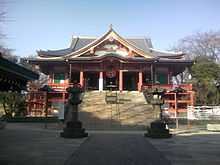Ryūsenji
| Ryūsenji | |
|---|---|
 Ryūsenji main hall | |
| Information | |
| Denomination | Tendai |
| Venerated | Fudō-myōō (Acala) |
| Founded | 808 |
| Address | 3-20-26 Shimomeguro, Meguro, Tokyo Prefecture 153-0064, Japan |
| Country | Japan |
Ryūsenji (瀧泉寺) also known as Meguro Fudō (目黒不動, "Black-eyed Fudō")[1] is a Tendai Buddhist temple in Meguro, Tokyo, Japan.[2]
The name of the surrounding district of "Meguro" derives its name from Ryūsenji's black-eyed statue of Meguro Fudō (Black-eyed Fudō-myōō, one of five protective Fudō-myōō statues placed at strategic points on the outskirts of Edo, the new capital of the Tokugawa shogunate, in the early seventeenth century by the abbot Tenkai, advisor to Tokugawa Ieyasu.[3] Each statue had eyes of a different color. (Another Tokyo ward, Mejiro is named for the white-eyed Fudō-myōō).
Ryūsenji is famed as the burial place of the romantic couple Hirai Gonpachi (平井権八) and Komurasaki (小紫), whose story was told in numerous Kabuki plays and in A.B. Mitford's Tales of Old Japan.[4]
The temple flourished during the Edo period, when Meguro was a popular pilgrimage site on the edge of Edo.[5]
-
_-_Kitao_Shigemasa.jpg)
Meguro Fudo Temple by Kitao Shigemasa, c. 1770.
-

Shirai Gonpachi by Kunisada, 1852, a Kabuki character based on Hirai Gonpachi.
References
- ↑ Setsuo Uenoda (1954). Calendar of annual events in Japan. Tokyo News Service. Retrieved 10 August 2013.
- ↑ Gyūichi Ōta (22 June 2011). The Chronicle of Lord Nobunaga. BRILL. pp. 59–. ISBN 978-90-04-20162-0. Retrieved 10 August 2013.
- ↑ Paul Waley, Tokyo: City of Stories (Tokyo: Weatherhill, 1991), 237.
- ↑ Paul Waley (1 June 1991). Tokyo: city of stories. Weatherhill. ISBN 978-0-8348-0227-8. Retrieved 10 August 2013.
- ↑ Sue Thompson (February 2007). Tokyo. New Holland Publishers. pp. 76–. ISBN 978-1-84537-650-5. Retrieved 10 August 2013.
| |||||||||||||||||||||||||||||||||||||||||||||||||||||
Coordinates: 35°37′43″N 139°42′29″E / 35.62861°N 139.70806°E